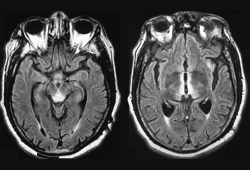Resumo
Definição
História e exame físico
Principais fatores diagnósticos
- história de cirurgia gastrointestinal
- lentidão mental, confusão, deficiência de concentração e apatia
- sinais oculomotores
- história de transtornos decorrentes do uso de bebidas alcoólicas
- condições preexistentes que predispõem à desnutrição: por exemplo, HIV/AIDS, câncer, anorexia/bulimia, vômitos prolongados ou diarreia
- tríade clássica: alterações no estado mental, oftalmoplegia e disfunção da marcha
Outros fatores diagnósticos
- irritabilidade leve
- psicose aguda
- coma
- miose, anisocoria, dissociação luz-perto
- papiledema, hemorragias retinianas
- taquicardia ou hipotensão
- hipotermia ou hipertermia
- perda auditiva, crises epilépticas e paraparesia espástica
- ataxia
Fatores de risco
- transtornos decorrentes do uso de bebidas alcoólicas
- Infecção por HIV e AIDS
- câncer e tratamento com agentes quimioterápicos
- desnutrição
- história de cirurgia gastrointestinal
- variantes genéticas associadas ao metabolismo e transporte alterados da tiamina
- transplante de medula óssea
- sexo masculino
Investigações diagnósticas
Primeiras investigações a serem solicitadas
- tentativa terapêutica de tiamina parenteral
- tiamina sérica
- ressonância nuclear magnética (RNM) cranioencefálica
- glicose sanguínea
- Hemograma completo
- eletrólitos séricos
- função renal
- TFHs
- análise toxicológica
- amônia sérica
- nível de álcool no sangue
Investigações a serem consideradas
- punção lombar
Algoritmo de tratamento
suspeita de encefalopatia de Wernicke
alto risco de deficiência de tiamina
Colaboradores
Autores
Gregory S. Day, MD, MSc, MSCI, FAAN, FANA, FANA
Associate Professor of Neurology
Division Director, Behavioural Neurology
Mayo Clinic in Florida
Jacksonville
FL
Declarações
GSD declares no competing interests directly relevant to this work. His research is supported by the National Institute of Health (U01AG057195, U01NS120901, U19AG032438). He serves as a consultant for Parabon NanoLabs, Inc. and as a topic editor (Dementia) for DynaMed (EBSCO). He is the co-project principal investigator for a clinical trial in anti-NMDAR encephalitis, which receives support from the National Institute of Neurological Disorders and Stroke (U01NS120901) and Amgen Pharmaceuticals, and a consultant for Arialys Therapeutics. He has developed and edited educational materials for Continuing Education, Inc. and Ionis Pharmaceuticals. GDS owns stock in ANI Pharmaceuticals. His institution has received support from Eli Lilly and Company for development and participation in an educational event promoting early diagnosis of symptomatic Alzheimer's disease, and in-kind contributions of radiotracer precursors for tau-PET neuroimaging in studies of memory and aging (via Avid Radiopharmaceuticals, a wholly owned subsidiary of Eli Lilly and Company).
Agradecimentos
Dr Gregory S. Day would like to gratefully acknowledge Dr Abhay Moghekar, a previous contributor to this topic. AM is a medical advisory board member of the Hydrocephalus Association and was reimbursed for travel and airfare. AM was a consultant to Quest Diagnostics and Orbees Incorporation for market research, receiving payment for consulting. AM undertook research for Fujirebio Diagnostics and received a research grant to his lab at Johns Hopkins University.
Revisores
Adrian Priesol, MD, FRCPC
Instructor
Massachusetts Eye and Ear Infirmary
Harvard Medical School
Boston
MA
Declarações
AP declares that he has no competing interests.
Créditos aos pareceristas
Os tópicos do BMJ Best Practice são constantemente atualizados, seguindo os desenvolvimentos das evidências e das diretrizes. Os pareceristas aqui listados revisaram o conteúdo pelo menos uma vez durante a história do tópico.
Declarações
As afiliações e declarações dos pareceristas referem--se ao momento da revisão.
Referências
Principais artigos
Galvin R, Bråthen G, Ivashynka A, et al. Guidelines for diagnosis, therapy and prevention of Wernicke encephalopathy. Eur J Neurol. 2010 Dec;17(12):1408-18.Texto completo Resumo
Artigos de referência
Uma lista completa das fontes referenciadas neste tópico está disponível para os usuários com acesso total ao BMJ Best Practice.

Diagnósticos diferenciais
- Intoxicação alcoólica
- Abstinência alcoólica
- Encefalite viral
Mais Diagnósticos diferenciaisDiretrizes
- Alcohol-use disorders: diagnosis and management of physical complications
- Guidelines for diagnosis, therapy and prevention of Wernicke encephalopathy
Mais DiretrizesConectar-se ou assinar para acessar todo o BMJ Best Practice
O uso deste conteúdo está sujeito ao nosso aviso legal